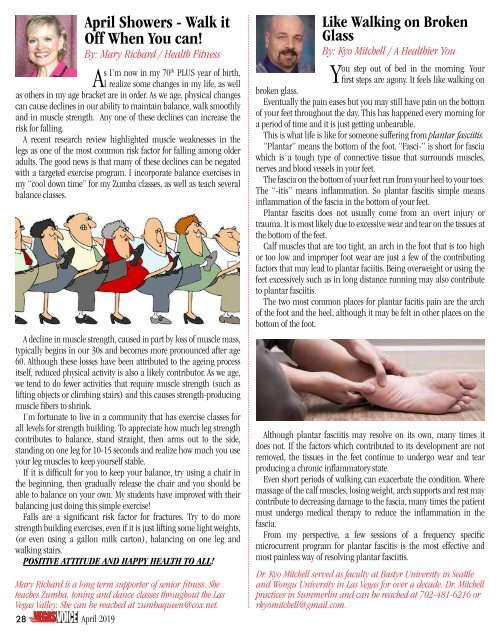You also want an ePaper? Increase the reach of your titles
YUMPU automatically turns print PDFs into web optimized ePapers that Google loves.
April Showers - Walk it<br />
Off When You can!<br />
By: Mary Richard / Health Fitness<br />
As I’m now in my 70 th PLUS year of birth,<br />
I realize some changes in my life, as well<br />
as others in my age bracket are in order. As we age, physical changes<br />
can cause declines in our ability to maintain balance, walk smoothly<br />
and in muscle strength. Any one of these declines can increase the<br />
risk for falling.<br />
A recent research review highlighted muscle weaknesses in the<br />
legs as one of the most common risk factor for falling among older<br />
adults. The good news is that many of these declines can be negated<br />
with a targeted exercise program. I incorporate balance exercises in<br />
my “cool down time” for my Zumba classes, as well as teach several<br />
balance classes.<br />
A decline in muscle strength, caused in part by loss of muscle mass,<br />
typically begins in our 30s and becomes more pronounced after age<br />
60. Although these losses have been attributed to the ageing process<br />
itself, reduced physical activity is also a likely contributor. As we age,<br />
we tend to do fewer activities that require muscle strength (such as<br />
lifting objects or climbing stairs) and this causes strength-producing<br />
muscle fibers to shrink.<br />
I’m fortunate to live in a community that has exercise classes for<br />
all levels for strength building. To appreciate how much leg strength<br />
contributes to balance, stand straight, then arms out to the side,<br />
standing on one leg for 10-15 seconds and realize how much you use<br />
your leg muscles to keep yourself stable.<br />
If it is difficult for you to keep your balance, try using a chair in<br />
the beginning, then gradually release the chair and you should be<br />
able to balance on your own. My students have improved with their<br />
balancing just doing this simple exercise!<br />
Falls are a significant risk factor for fractures. Try to do more<br />
strength building exercises, even if it is just lifting some light weights,<br />
(or even using a gallon milk carton), balancing on one leg and<br />
walking stairs.<br />
POSITIVE ATTITUDE AND HAPPY HEALTH TO ALL!<br />
Mary Richard is a long term supporter of senior fitness. She<br />
teaches Zumba, toning and dance classes throughout the Las<br />
<strong>Vegas</strong> Valley. She can be reached at zumbaqueen@cox.net.<br />
28<br />
April 20<strong>19</strong><br />
Like Walking on Broken<br />
Glass<br />
By: Kyo Mitchell / A Healthier You<br />
You step out of bed in the morning. Your<br />
first steps are agony. It feels like walking on<br />
broken glass.<br />
Eventually the pain eases but you may still have pain on the bottom<br />
of your feet throughout the day. This has happened every morning for<br />
a period of time and it is just getting unbearable.<br />
This is what life is like for someone suffering from plantar fasciitis.<br />
“Plantar” means the bottom of the foot. “Fasci-” is short for fascia<br />
which is a tough type of connective tissue that surrounds muscles,<br />
nerves and blood vessels in your feet.<br />
The fascia on the bottom of your feet run from your heel to your toes.<br />
The “-itis” means inflammation. So plantar fascitis simple means<br />
inflammation of the fascia in the bottom of your feet.<br />
Plantar fascitis does not usually come from an overt injury or<br />
trauma. It is most likely due to excessive wear and tear on the tissues at<br />
the bottom of the feet.<br />
Calf muscles that are too tight, an arch in the foot that is too high<br />
or too low and improper foot wear are just a few of the contributing<br />
factors that may lead to plantar faciitis. Being overweight or using the<br />
feet excessively such as in long distance running may also contribute<br />
to plantar fasciitis.<br />
The two most common places for plantar facitis pain are the arch<br />
of the foot and the heel, although it may be felt in other places on the<br />
bottom of the foot.<br />
Although plantar fasciitis may resolve on its own, many times it<br />
does not. If the factors which contributed to its development are not<br />
removed, the tissues in the feet continue to undergo wear and tear<br />
producing a chronic inflammatory state.<br />
Even short periods of walking can exacerbate the condition. Where<br />
massage of the calf muscles, losing weight, arch supports and rest may<br />
contribute to decreasing damage to the fascia, many times the patient<br />
must undergo medical therapy to reduce the inflammation in the<br />
fascia.<br />
From my perspective, a few sessions of a frequency specific<br />
microcurrent program for plantar fascitis is the most effective and<br />
most painless way of resolving plantar fasciitis.<br />
Dr. Kyo Mitchell served as faculty at Bastyr University in Seattle<br />
and Wongu University in Las <strong>Vegas</strong> for over a decade. Dr. Mitchell<br />
practices in Summerlin and can be reached at 702-481-6216 or<br />
rkyomitchell@gmail.com.

















